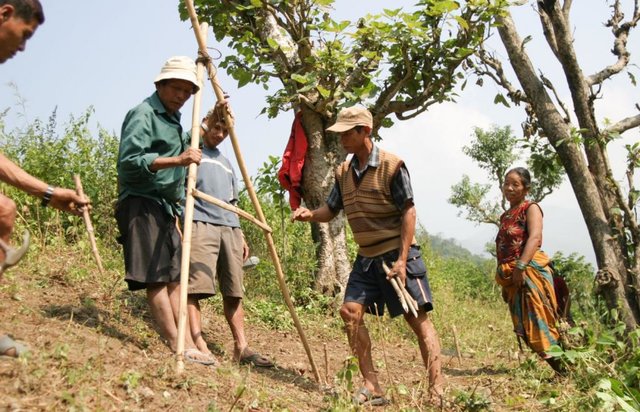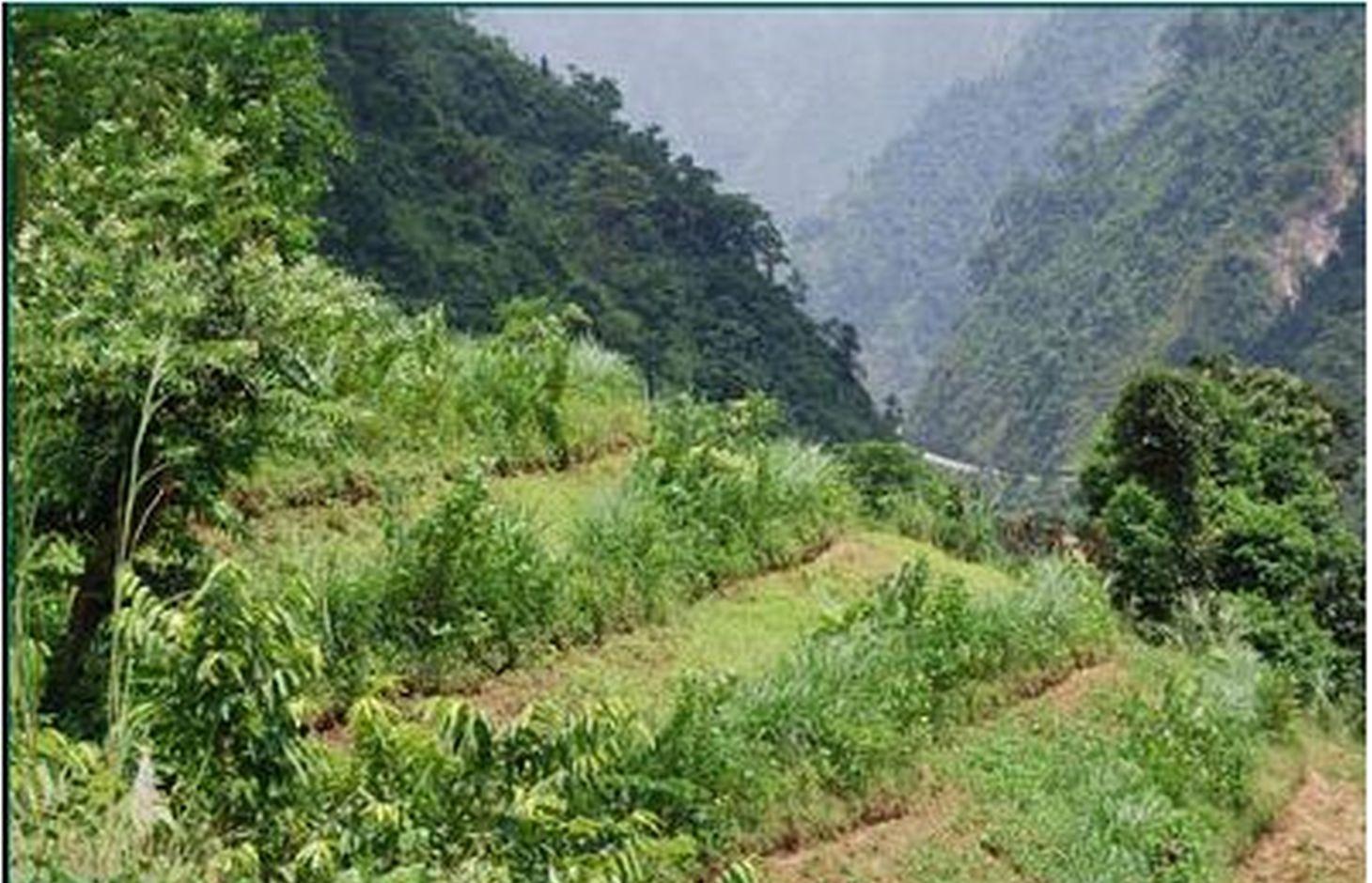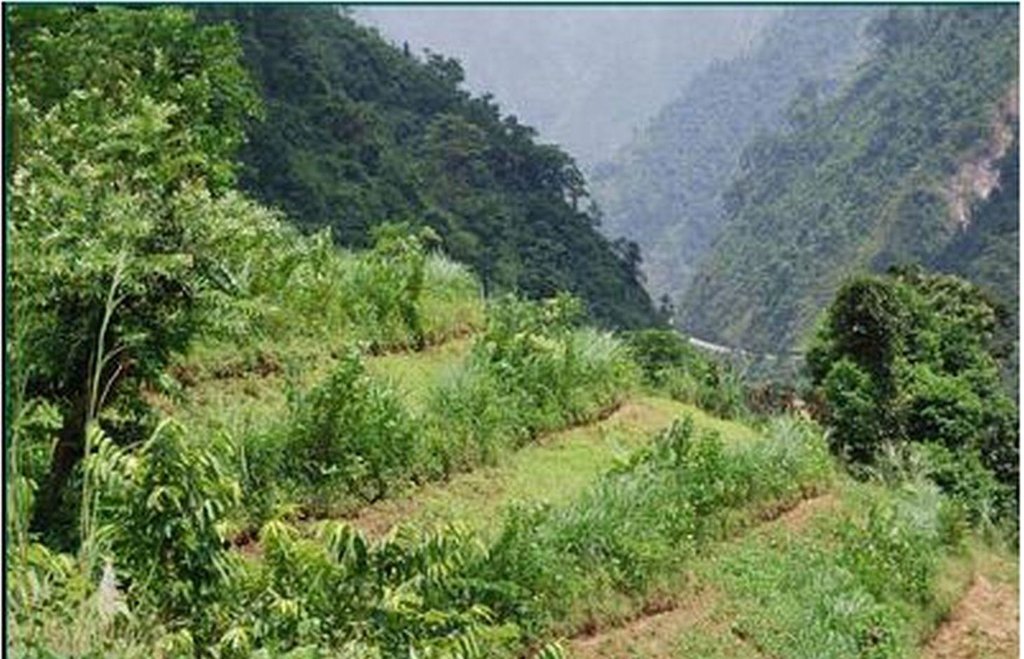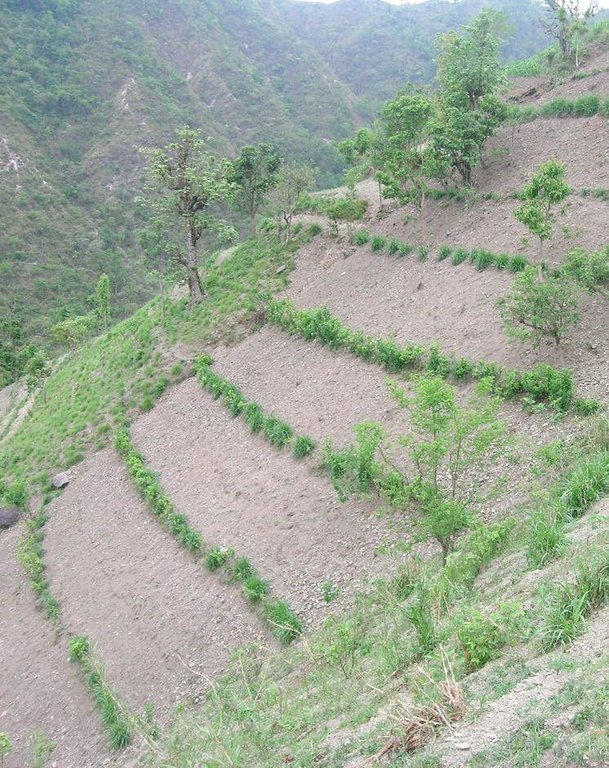Hedgerow technology [Népal]
- Création :
- Mise à jour :
- Compilateur : Shreedip Sigdel
- Rédacteur : –
- Examinateur : David Streiff
Ghase har Prabadhi (Main Contributor: Gyanbandhu Sharma, LI-BIRD)
technologies_1685 - Népal
Voir les sections
Développer tout Réduire tout1. Informations générales
1.2 Coordonnées des personnes-ressources et des institutions impliquées dans l'évaluation et la documentation de la Technologie
Spécialiste GDT:
Nom du ou des institutions qui ont facilité la documentation/ l'évaluation de la Technologie (si pertinent)
Local Initiatives for Biodiversity, Research, and Development (LI-BIRD) - NépalNom du ou des institutions qui ont facilité la documentation/ l'évaluation de la Technologie (si pertinent)
ICIMOD International Centre for Integrated Mountain Development (ICIMOD) - Népal1.3 Conditions relatives à l'utilisation par WOCAT des données documentées
Quand les données ont-elles été compilées (sur le terrain)?
01/03/2013
Le compilateur et la(les) personne(s) ressource(s) acceptent les conditions relatives à l'utilisation par WOCAT des données documentées:
Oui
1.5 Référence au(x) questionnaire(s) sur les Approches de GDT

Participatory hedgerow management [Népal]
Hedgerow technology can be introduced through the joint participation of farmers, scientists, and related stakeholders. The whole community works together at all stages, including designing, planning, implementation, monitoring and evaluation, and scaling up.
- Compilateur : Shreedip Sigdel
2. Description de la Technologie de GDT
2.1 Courte description de la Technologie
Définition de la Technologie:
A technology that uses hedgerows to help establish terraces on sloping land; farmers learn improved methods to manage a cultivation practice that stabilizes the soil, enhances food production, and adds to on-farm cash income.
2.2 Description détaillée de la Technologie
Description:
Hedgerow technology provides options and opportunities for farmers working on sloping land. These hedgerows are a soil conservation measure but they also help to generate additional biomass and fodder and/or income for marginal farmers; in addition, they offer the added benefit of helping to balance the ecosystem and to address climate change by encouraging biodiversity. This improved version of a local technology makes maximum use of indigenous knowledge and adds to it by making available the latest scientific knowledge.
Purpose of the Technology: Farmers have traditionally selected plants for hedgerow cultivation based on practical considerations such as the availability of seeds and seedlings, how well seeds germinate, how well the plants grow and how well they can be coppiced, their branching habit, the amount of biomass they can produce, and how much cash the crop can generate. They made these choices without the benefit of any external input or scientific knowledge, relying solely on what they have been able to observe locally over the years. The participatory technology development process aims to help farmers by providing them with scientific input to augment their traditional knowledge on the selection, plan, and design of hedgerows. Over a very short time, the farmers learn to make good use of the new information and start enjoying the benefits that the improved agriculture yields in terms of social, economic, and environmental benefits.
Establishment / maintenance activities and inputs: The following steps outline how hedgerows can be established on sloping land:
• A participatory designing and planning process is used to choose which sloping lands will be cultivated and to select which hedgerow species are to be planted. Trained manpower is recruited with the help of farmers and other related stakeholders.
• The necessary materials such as A-frames, seeds, and seedlings are prepared.
• The technology is implemented in the field by trained manpower.
• The hedgerow seedlings are regularly maintained.
• The land users participate in periodic monitoring and evaluation of the technology. They report on progress and provide feedback.
2.3 Photos de la Technologie
2.5 Pays/ région/ lieux où la Technologie a été appliquée et qui sont couverts par cette évaluation
Pays:
Népal
Autres spécifications du lieu:
Gorkha, Tanhun, Chitwan, Makwanpur, Nawalparasi, Dhading district
2.7 Introduction de la Technologie
Spécifiez comment la Technologie a été introduite: :
- au cours d'expérimentations / de recherches
3. Classification de la Technologie de GDT
3.1 Principal(aux) objectif(s) de la Technologie
- réduire, prévenir, restaurer les terres dégradées
3.2 Type(s) actuel(s) d'utilisation des terres, là où la Technologie est appliquée

Terres cultivées
- Cultures annuelles

Mixte (cultures/ pâturages/ arbres), incluant l'agroforesterie
- Agroforesterie
Commentaires:
Major land use problems (compiler’s opinion): Noticeable soil erosion, decreased soil fertility, diminished productivity, and lower moisture content in areas that have sloping lands and in areas where shifting cultivation is or was practised. Plots that had previously been farmed by the method of shifting cultivation, where plots are allowed to lie fallow for a number of years, are now cultivated annually. This land use change is worrying because shifting cultivation has traditionally been practised in areas where the quality of the soil is poor and cannot support annual crop production year on year.
3.3 Informations complémentaires sur l'utilisation des terres
Approvisionnement en eau des terres sur lesquelles est appliquée la Technologie:
- pluvial
Nombre de période de croissance par an: :
- 2
3.4 Groupe de GDT auquel appartient la Technologie
- mesures en travers de la pente
3.5 Diffusion de la Technologie
Spécifiez la diffusion de la Technologie:
- répartie uniformément sur une zone
Si la Technologie est uniformément répartie sur une zone, indiquez la superficie couverte approximative:
- 1-10 km2
3.6 Mesures de GDT constituant la Technologie

pratiques végétales
- V1: Couverture d’arbres et d’arbustes

modes de gestion
- M1: Changement du type d’utilisation des terres
3.7 Principaux types de dégradation des terres traités par la Technologie

érosion hydrique des sols
- Wt: perte de la couche superficielle des sols (couche arable)/ érosion de surface

dégradation chimique des sols
- Cn: baisse de la fertilité des sols et réduction du niveau de matière organique (non causée par l’érosion)
Commentaires:
Main causes of degradation: soil management, deforestation / removal of natural vegetation (incl. forest fires), Heavy / extreme rainfall (intensity/amounts), droughts
3.8 Prévention, réduction de la dégradation ou réhabilitation des terres dégradées
Spécifiez l'objectif de la Technologie au regard de la dégradation des terres:
- prévenir la dégradation des terres
4. Spécifications techniques, activités, intrants et coûts de mise en œuvre
4.1 Dessin technique de la Technologie
4.2 Spécification/ explications techniques du dessin technique
Hedgerow technology on sloping land; note that the hedgerows help to stabilize the land and to control soil erosion and runoff.
Technical knowledge required for field staff / advisors: moderate
Technical knowledge required for land users: moderate
Main technical functions: control of dispersed runoff: retain / trap, Prevent Soil erosion
Secondary technical functions: reduction of slope angle, stabilisation of soil (eg by tree roots against land slides), increase in nutrient availability (supply, recycling,…)
4.3 Informations générales sur le calcul des intrants et des coûts
Spécifiez la manière dont les coûts et les intrants ont été calculés:
- par superficie de la Technologie
Indiquez la taille et l'unité de surface:
ha
Indiquez la monnaie utilisée pour le calcul des coûts:
- dollars US
Indiquez le coût salarial moyen de la main d'œuvre par jour:
2.7
4.4 Activités de mise en place/ d'établissement
| Activité | Type de mesures | Calendrier | |
|---|---|---|---|
| 1. | The equipment that is needed for planting is collected and prepared; this can include such things as A-frames, spades, and sickles.• The hillside where the technology is to be implemented is first cleaned and groomed to make way for the new hedgerows.• Contour lines are demarcated.• The seeds and/or seedlings are planted along the contour lines. | Végétale |
4.5 Coûts et intrants nécessaires à la mise en place
| Spécifiez les intrants | Unité | Quantité | Coûts par unité | Coût total par intrant | % des coût supporté par les exploitants des terres | |
|---|---|---|---|---|---|---|
| Main d'œuvre | Prepare and plant along the contour lines | persons/day/ha | 10,0 | 2,7 | 27,0 | 100,0 |
| Equipements | Tools | ha | 1,0 | 32,0 | 32,0 | 100,0 |
| Matériel végétal | Seedlings | ha | 1,0 | 68,0 | 68,0 | 100,0 |
| Coût total de mise en place de la Technologie | 127,0 | |||||
4.6 Activités d'entretien/ récurrentes
| Activité | Type de mesures | Calendrier/ fréquence | |
|---|---|---|---|
| 1. | The hedgerows are weeded and cleaned to discourage unwantedplants and pests.• Enrichment planting• The hedgerows are pruned and the clippings are mulched.• Manuring | Végétale |
4.7 Coûts et intrants nécessaires aux activités d'entretien/ récurrentes (par an)
| Spécifiez les intrants | Unité | Quantité | Coûts par unité | Coût total par intrant | % des coût supporté par les exploitants des terres | |
|---|---|---|---|---|---|---|
| Main d'œuvre | Maintenance of hedgerows | persons/day/ha | 26,0 | 2,7 | 70,2 | 100,0 |
| Matériel végétal | Seedlings | ha | 1,0 | 34,0 | 34,0 | 100,0 |
| Engrais et biocides | Compost / manure | ha | 1,0 | 20,0 | 20,0 | 100,0 |
| Coût total d'entretien de la Technologie | 124,2 | |||||
4.8 Facteurs les plus importants affectant les coûts
Décrivez les facteurs les plus importants affectant les coûts :
The cost of implementing this technology is dependent on the gradient of the slope (and other geographical features), the local cost of the seeds or seedlings, and the availability of labour.
The technology has a low to average cost for implementation. Locally available seeds and seedlings and locally trained manpower and resources are valuable low-cost inputs for implementation. The technology has a higher likelihood of adoption in some social and physiographic areas, especially where land users can integrate their own expertise with scientific knowledge. Many factors play a role in determining whether the technology is effective and sustainable and whether farmers are willing to adopt it; these include that if the technology is demand driven, it is more likely to be adopted, and if land users can use inexpensive local resources they are more likely to try it.
All costs and amounts are rough estimates by the technicians and authors
5. Environnement naturel et humain
5.1 Climat
Précipitations annuelles
- < 250 mm
- 251-500 mm
- 501-750 mm
- 751-1000 mm
- 1001-1500 mm
- 1501-2000 mm
- 2001-3000 mm
- 3001-4000 mm
- > 4000 mm
Zone agro-climatique
- subhumide
Thermal climate class: subtropics
5.2 Topographie
Pentes moyennes:
- plat (0-2 %)
- faible (3-5%)
- modéré (6-10%)
- onduleux (11-15%)
- vallonné (16-30%)
- raide (31-60%)
- très raide (>60%)
Reliefs:
- plateaux/ plaines
- crêtes
- flancs/ pentes de montagne
- flancs/ pentes de colline
- piémonts/ glacis (bas de pente)
- fonds de vallée/bas-fonds
Zones altitudinales:
- 0-100 m
- 101-500 m
- 501-1000 m
- 1001-1500 m
- 1501-2000 m
- 2001-2500 m
- 2501-3000 m
- 3001-4000 m
- > 4000 m
5.3 Sols
Profondeur moyenne du sol:
- très superficiel (0-20 cm)
- superficiel (21-50 cm)
- modérément profond (51-80 cm)
- profond (81-120 cm)
- très profond (>120 cm)
Texture du sol (de la couche arable):
- grossier/ léger (sablonneux)
Matière organique de la couche arable:
- moyen (1-3%)
Si disponible, joignez une description complète du sol ou précisez les informations disponibles, par ex., type de sol, pH/ acidité du sol, capacité d'échange cationique, azote, salinité, etc.
Soil fertility is low
Soil drainage / infiltration is poor
Soil water storage capacity is low
5.4 Disponibilité et qualité de l'eau
Profondeur estimée de l’eau dans le sol:
> 50 m
Disponibilité de l’eau de surface:
faible/ absente
Qualité de l’eau (non traitée):
eau inutilisable
5.5 Biodiversité
Diversité des espèces:
- faible
5.6 Caractéristiques des exploitants des terres appliquant la Technologie
Orientation du système de production:
- subsistance (auto-approvisionnement)
Revenus hors exploitation:
- 10-50% de tous les revenus
Niveau relatif de richesse:
- pauvre
Individus ou groupes:
- individu/ ménage
Niveau de mécanisation:
- travail manuel
- traction animale
Indiquez toute autre caractéristique pertinente des exploitants des terres:
Population density: 10-50 persons/km2
Annual population growth: 3% - 4%
5.7 Superficie moyenne des terres détenues ou louées par les exploitants appliquant la Technologie
- < 0,5 ha
- 0,5-1 ha
- 1-2 ha
- 2-5 ha
- 5-15 ha
- 15-50 ha
- 50-100 ha
- 100-500 ha
- 500-1 000 ha
- 1 000-10 000 ha
- > 10 000 ha
Cette superficie est-elle considérée comme de petite, moyenne ou grande dimension (en se référant au contexte local)?
- petite dimension
5.8 Propriété foncière, droits d’utilisation des terres et de l'eau
Propriété foncière:
- individu, avec titre de propriété
5.9 Accès aux services et aux infrastructures
santé:
- pauvre
- modéré
- bonne
éducation:
- pauvre
- modéré
- bonne
assistance technique:
- pauvre
- modéré
- bonne
emploi (par ex. hors exploitation):
- pauvre
- modéré
- bonne
marchés:
- pauvre
- modéré
- bonne
énergie:
- pauvre
- modéré
- bonne
routes et transports:
- pauvre
- modéré
- bonne
eau potable et assainissement:
- pauvre
- modéré
- bonne
services financiers:
- pauvre
- modéré
- bonne
6. Impacts et conclusions
6.1 Impacts sur site que la Technologie a montrés
Impacts socio-économiques
Production
production agricole
production fourragère
diversité des produits
Disponibilité et qualité de l'eau
demande pour l'eau d'irrigation
Commentaires/ spécifiez:
Reduce need for external agriculture inputs
Revenus et coûts
dépenses pour les intrants agricoles
diversité des sources de revenus
Autres impacts socio-économiques
Initial cost
very steep slope (>30 degree)
time to become well established
Impacts socioculturels
sécurité alimentaire/ autosuffisance
institutions communautaires
connaissances sur la GDT/ dégradation des terres
Empowerment of the community
livelihood and human well-being
Commentaires/ spécifiez:
The hedgerows provide fodder and forage for animals; selling or bartering fodder helps to diversify food sources for humans and can also be a significant source of income.
Impacts écologiques
Cycle de l'eau/ ruissellement
ruissellement de surface
Sols
humidité du sol
matière organique du sol/ au dessous du sol C
Biodiversité: végétale, animale
biomasse/ au dessus du sol C
diversité végétale
contrôle des animaux nuisibles/ maladies
Autres impacts écologiques
competition for water, sunlight and nutrients
6.2 Impacts hors site que la Technologie a montrés
envasement en aval
capacité tampon/de filtration
6.3 Exposition et sensibilité de la Technologie aux changements progressifs et aux évènements extrêmes/catastrophes liés au climat (telles que perçues par les exploitants des terres)
Extrêmes climatiques (catastrophes)
Catastrophes météorologiques
| Comment la Technologie fait-elle face à cela? | |
|---|---|
| pluie torrentielle locale | pas bien |
Catastrophes climatiques
| Comment la Technologie fait-elle face à cela? | |
|---|---|
| sécheresse | bien |
Commentaires:
Farmers selected species with deep root to adopt to climate extremes
6.4 Analyse coûts-bénéfices
Quels sont les bénéfices comparativement aux coûts de mise en place (du point de vue des exploitants des terres)?
Rentabilité à court terme:
positive
Rentabilité à long terme:
très positive
Quels sont les bénéfices comparativement aux coûts d'entretien récurrents (du point de vue des exploitants des terres)?
Rentabilité à court terme:
positive
Rentabilité à long terme:
très positive
6.5 Adoption de la Technologie
- 10-50%
Si disponible, quantifiez (nombre de ménages et/ou superficie couverte):
450 households in an area of 1- 10 sq km (10 - 50 persons per sq km)
Parmi tous ceux qui ont adopté la Technologie, combien d'entre eux l'ont fait spontanément, à savoir sans recevoir aucune incitation matérielle ou aucun paiement?
- 90-100%
Commentaires:
25% of land user families have adopted the Technology without any external material support
450 land user families have adopted the Technology without any external material support
Comments on spontaneous adoption: One quarter of the total land users (about 450 families) in the areas studied adopted this technology voluntarily without any external support.
6.7 Points forts/ avantages/ possibilités de la Technologie
| Points forts/ avantages/ possibilités du point de vue du compilateur ou d'une autre personne ressource clé |
|---|
|
Effective control of soil erosion on sloping land How can they be sustained / enhanced? This vegetative measure of planting along contour lines can be sustained in the long run by initially selecting species preferred by farmers and by continuing to maintain them |
|
Improved soil fertility How can they be sustained / enhanced? Hedgerows help to increase soil fertility because they trap water and sediment on the terraces; leguminous hedgerow plants fix nitrogen in the soil and when they are mulched their residues increase organic matter in the soil. |
|
Quality fodder and forage production How can they be sustained / enhanced? Hedgerows produce fodder and forage for livestock |
|
Bioterracing How can they be sustained / enhanced? When leguminous plants with deep roots are used in the hedgerows they help to anchor the edges and over time, as the soil accumulates, bioterraces are established. |
|
High adoption potential How can they be sustained / enhanced? This technology is simple to implement using only local resources and is assured of replication since it was demand driven |
6.8 Faiblesses/ inconvénients/ risques de la Technologie et moyens de les surmonter
| Faiblesses/ inconvénients/ risques du point de vue du compilateur ou d'une autre personne ressource clé | Comment peuvent-ils être surmontés? |
|---|---|
| Hedgerows are difficult to establish on steep slopes and in areas where the soil is dry and degraded | Increase moisture in the soil by mulching the hedges |
| Hedgerows take a long time to establish | Increase the amount of manure (compost, crop residue) added to the hedgerows and add more frequently. Increase the frequency of weeding and cleaning. |
| It is difficult to establish bio-terraces on steep land | Reduce the spacing between hedgerows and grow tree species. Remember that that this technology is not recommend for very steep slopes |
| High initial cost | Make maximum use of local resources and local labour |
| Hedgerows threatened by free grazing of animals | Control grazing in the area |
7. Références et liens
7.2 Références des publications disponibles
Titre, auteur, année, ISBN:
Factors responsible for acceptance or rejection of SALT and other technological options suitable for shifting and sloping land cultivation areas, Technical Paper submitted to Hill Agriculture Research Project (HARP), Regmi, BR; et al. (2004),
Titre, auteur, année, ISBN:
A resource book: Integrated hedgerow technology (in Nepali), Sharma, G; Regmi, BR; Tamang, BB; Shrestha, PK (2008)
Titre, auteur, année, ISBN:
Manual on contour hedgerow inter-cropping technology, ICIMOD, 1999
Titre, auteur, année, ISBN:
Impact of contour hedgerows: A case study, Focus on Godavari No 3. Kathmandu, Nepal: ICIMOD, Ya, T; Murray, AB (eds) (2004)
Liens et modules
Développer tout Réduire toutLiens

Participatory hedgerow management [Népal]
Hedgerow technology can be introduced through the joint participation of farmers, scientists, and related stakeholders. The whole community works together at all stages, including designing, planning, implementation, monitoring and evaluation, and scaling up.
- Compilateur : Shreedip Sigdel
Modules
Aucun module trouvé





